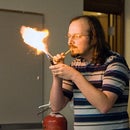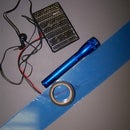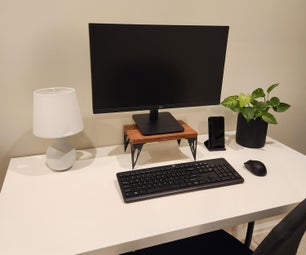Introduction: Determine the Speed of Sound
I will go through a process that will allow you to determine the speed sound travels. This is a classic physics lab that in the past would have required lots of expensive equipment. The only expensive equipment involved here is a computer with a microphone input. Which by itself can be expensive, but most classrooms these days have at least one in the room.
Step 1: Stuff You Need
1. Computer with microphone input
2. Microphone you can plug into the computer
3. Long tube. I typically use discarded carpet tube (which is free), but you can use PVC pipe. 1.5 m to 2 m in length is best.
4. An audio recording program. I recommend Audacity. [http://audacity.sourceforge.net/]
Step 2: Record Your Sound
Stand the tube up on a hard surface or place against a wall. Hold the microphone right at the opening of the tube. Start recording in Audacity. Snap your fingers near the microphone. A weak, pathetic snap tends to work better than a strong one. Snap a few more times so that your odds of having a good one will increase.
Note, you want your hand above the microphone to get the most precise answer.
Step 3: Zoom In
Click and drag over one of the peaks and zoom in. The easiest way is to click the "Zoom to Fit" button.
Step 4: Zoom in Again
Now you should see two sets of peaks. If you still only see one, highlight a smaller area and zoom in again.
The first set of peaks is your snap. The second is the echo of your snap.
Highlight just the two sets of peaks and zoom again.
Step 5: Really Precise Stopwatch
Now we can easily see the recording of our snap and the echo of our snap. All we need to do now is determine how long it took the sound to travel from the mouth of the tube to the floor and back again.
The easiest way (as pointed out by one of my students) is to click and drag from the beginning of the sound to the beginning of the echo. If you look near the bottom of the window you'll be able to see how much time you've highlighted.
For mine I get a time of 0.009057 seconds. I figure four significant figures is pretty good. Now I simply measure the length of my tube, which in this case was 1.548 m. Since the sound has to go there and back again I double this distance (almost everyone forgets to do this the first time).
Speed can be calculated by dividing distance by time.
So v = d/t; v = 3.096/0.009057
v = 341.8 m/s or 764.6 mph
The accepted value at sea level is 340.29 m/s (the value in my classroom can be anywhere between 340 m/s and about 348 m/s depending on the weather).













